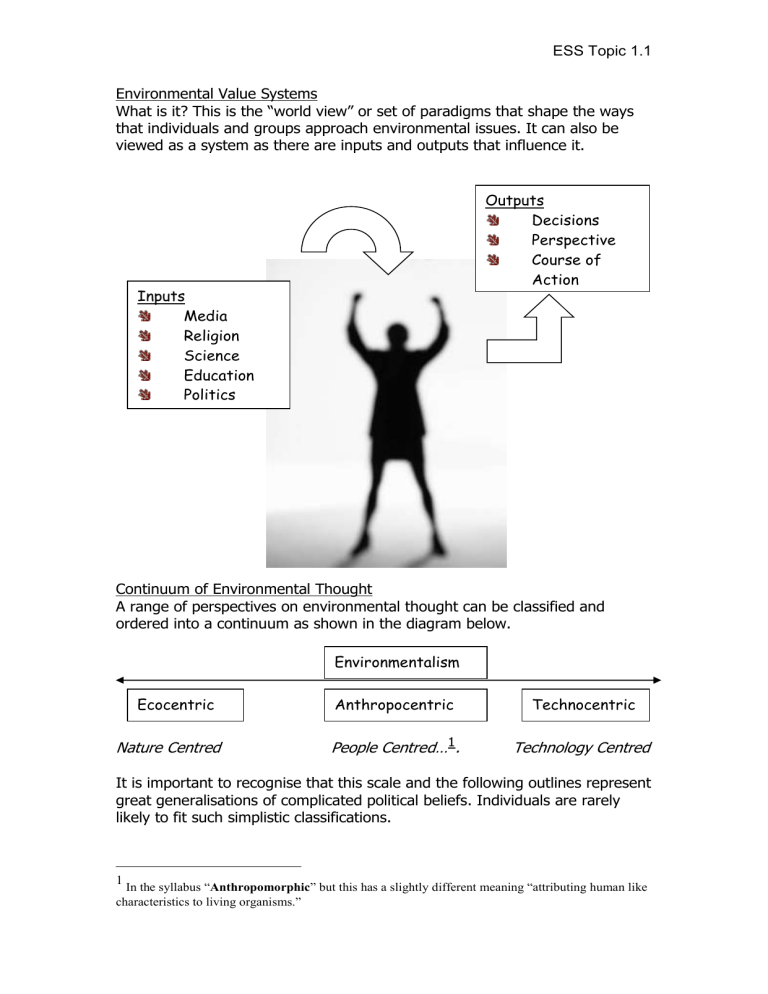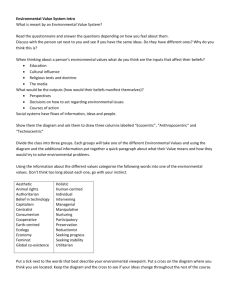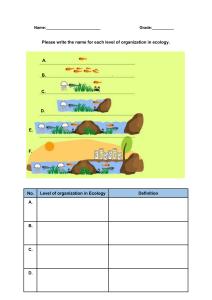
ESS Topic 1.1 Environmental Value Systems What is it? This is the “world view” or set of paradigms that shape the ways that individuals and groups approach environmental issues. It can also be viewed as a system as there are inputs and outputs that influence it. Outputs Decisions Perspective Course of Action Inputs Media Religion Science Education Politics Culture Continuum of Environmental Thought A range of perspectives on environmental thought can be classified and ordered into a continuum as shown in the diagram below. Environmentalism Ecocentric Nature Centred Anthropocentric Technocentric People Centred…1. Technology Centred It is important to recognise that this scale and the following outlines represent great generalisations of complicated political beliefs. Individuals are rarely likely to fit such simplistic classifications. 1 In the syllabus “Anthropomorphic” but this has a slightly different meaning “attributing human like characteristics to living organisms.” ESS Topic 1.1 ECOCENTRIC PERSPECTIVES “Humankind has not woven the web of life. We are but one thread within it. Whatever we do to the web, we do to ourselves. All things are bound together. All things connect.” Chief Seattle, 1855 “We abuse land because we regard it as a commodity belonging to us. When we see land as a community to which we belong, we may begin to use it with love and respect.” Aldo Leopold, A Sand County Almanac The philosophy of Deep Ecology Arne Naess is widely regarded as the father of the deep ecology movement, a Norwegian university professor who first outlined this perspective in his book Ecology, Community and Lifestyle. Central to his ideas is a spiritual belief that human desire was a driving factor in the whole process of environmental degradation. Naess believes that spiritual impoverishment leads to this desire and that this is the driving force behind rapid rise of the global consumer, which has parallels in Buddhist teaching. There are also parallels in the writings of American wilderness authors such as Leopold and Thoreau Self Reliance Ecologists Based on the promotion of self sufficiency in resource management. The influences are not necessarily the spiritual ideas of deep ecology, it may stem from other academic readings or other inputs. Systems of land use management such as Bill Mollison’s “permaculture” demonstrate how resources can be used more sustainably in way that integrates diverse farming and resource sharing through local economy trading systems (LETS). In economics the teachings of EF Schumacher in his book “Small is Beautiful” focused on the benefits of small scale economy in contrast to the large scale economies promoted under capitalism or communism. Radical Perspectives Non-violent direct action (NVDA), following in the techniques of Mahatma Gandhi have come to be the course of action chosen by NGO’s such as Greenpeace (Whaling protests, Nuclear testing protests) and Earth First! (No Compromise in the Defence of Mother Earth). Throughout Britain in the 1990’s there were many examples of protests organized such as “Pure Genius Campaign” encouraging the homeless to squat on land owned by Guinness in London (Key NGO -The land is ours – for protection of common land, and applying permaculture techniques to the management of this land). The Earth First! style protests at Twyford Down by the Donga Tribe and A380 road protests by Swampy, Animal et al. The social ecologist Murray Bookchin accuses the whole deep ecology, perspective of being “politically naïve” and “intellectually impoverished”. His more anthropocentric approach to environmental problems stemming from his own radical political beliefs. Other criticisms of the ecocentric schools of ESS Topic 1.1 thought include the notion that ecocentrism promotes misanthropy, or dislike of general society. Connected to this is the idea that many ecocentred prophesies of doom may lead to a loss of faith in the ability of society to change and paradoxically help to fulfill those prophesies. ANTHROPOCENTRIC PERSPECTIVES “The most serious, insidious danger in the environmental movement is that it may sap the will of advanced communities to face the problems which no doubt lie ahead. Throughout history, hope for the future has been a powerful incentive for constructive change.” Maddox (1972) in Environmentalism T. O’Riordan Environmental Managers This perspective does not see any need for a radical political agenda along the lines of some ecocentred approaches, but instead are working to change the existing social and political structures. Those believing in this perspective are unlikely to see a problem with current economic growth that cannot be resolved by legal means or political agreement. It is the typical approach of those working as Civil Servants for English Nature, Department for the Environment, or for the United Nations. The kind of policy influence of NGOs such as “Friends of the Earth” would be typical of this approach. Campaign material is designed to influence existing government structures to solve environmental problems. TECHNOCENTRIC PERSPECTIVES “Necessity is the mother of invention” Cornucopian Perspective A perspective that doesn’t really see a problem as humans have always found a way out of difficulties in the past. New resources and technologies will solve any environmental problems as they are encountered. There is no need for radical agendas, or socio-economic, or political reform. Often associated with the idea of “frontier economics” – the seemingly boundless resources found by pioneers and with free market led development. It can also be associated with technical scientific approaches to manage the environment (although not necessarily both of these together). (see syllabus for review of main ideas) IUCN Founded Minamata, Japan – First death from mercury pollution Beginnings of the UN Law of the Sea World Population Reaches 3 Billion WWF Founded Rachel Carson’s Silent Spring Published UN Biosphere Conference First Earth Day in the USA UNEP created; the Stockholm Conference Women in the Himalayas, Northern India Stare the Chipko Movement, protecting trees CITES started World Population Reaches 4 Billion UN Habitat Conference on City Living Conditions World Climate Conference demands urgent attention to the enhanced greenhouse effect. The World Conservation Strategy Bhopal Disaster – 2,800 die. Antarctic Ozone Hole discovered Chernobyl Disaster World Population Reaches 5 Billion The Brundtland Report on Ennvironment and Development Montreal Protocol The Earth Summit in Rio de Janiero Habitat II conference – “The City Summit” Kyoto Protocol World Population Reaches 6 Billion The World Summit on Sustainable Development in Johannesburg Nairobi Climate Change Conference 1948 1956 1958 1960 1961 1962 1968 1970 1972 1973 1974 1974 1976 1979 1980 1984 1985 1986 1987 1987 1987 1992 1996 1997 1999 2002 2006 Timeline of Key Developments in the Global Conservation Movement ESS Topic 1.1


